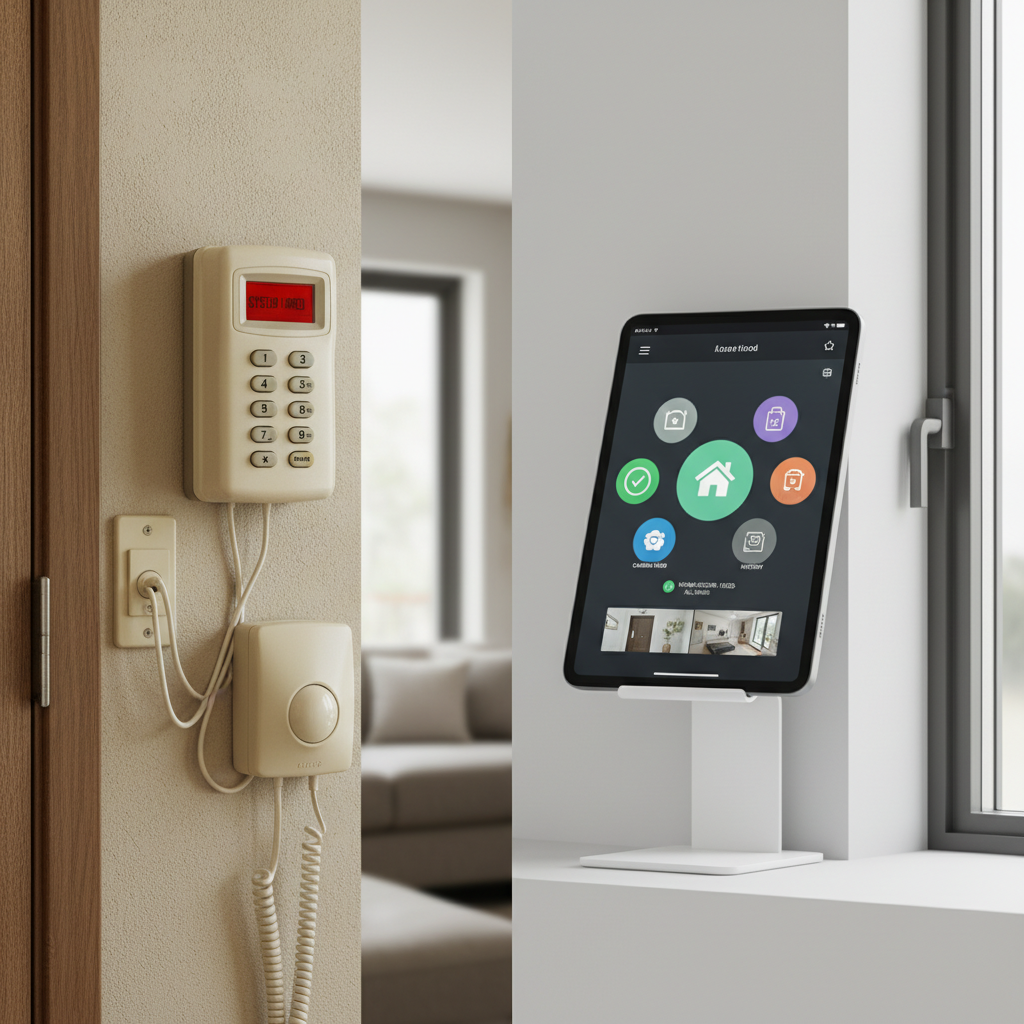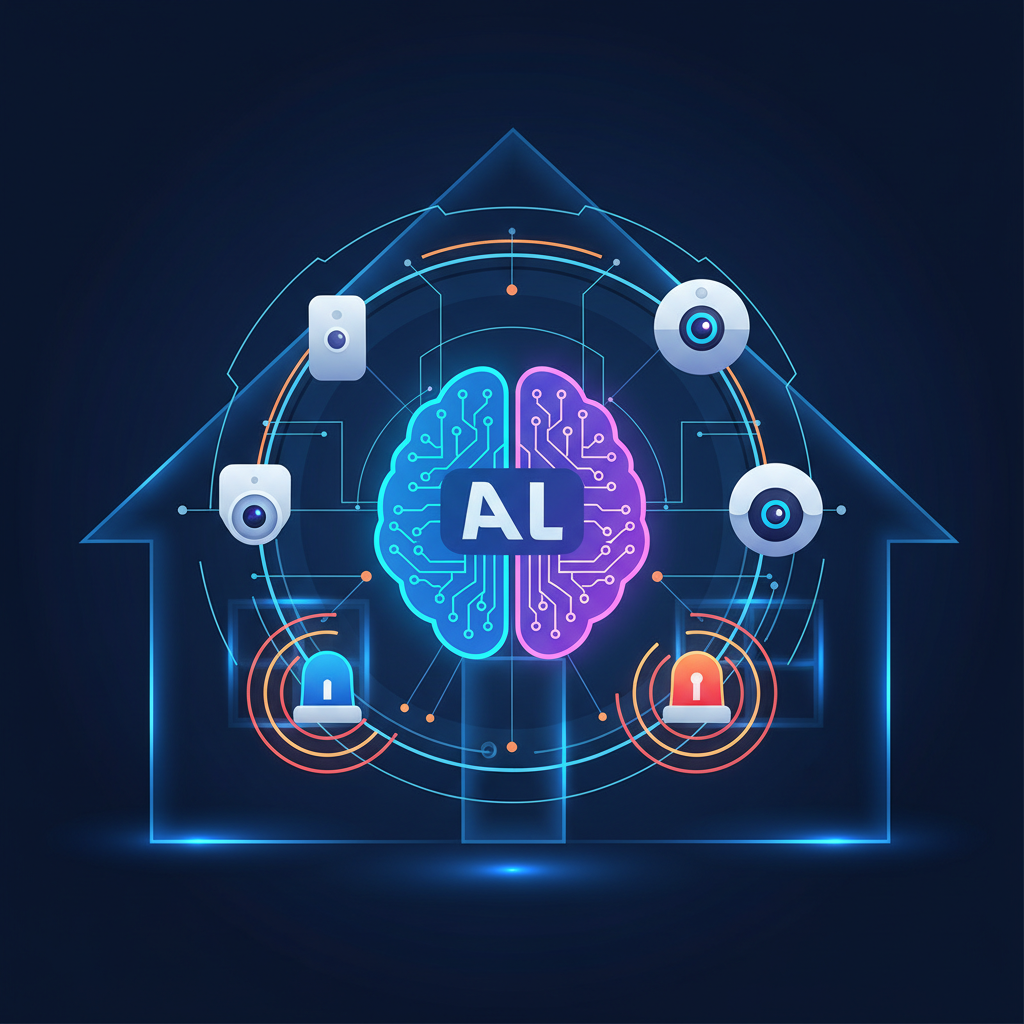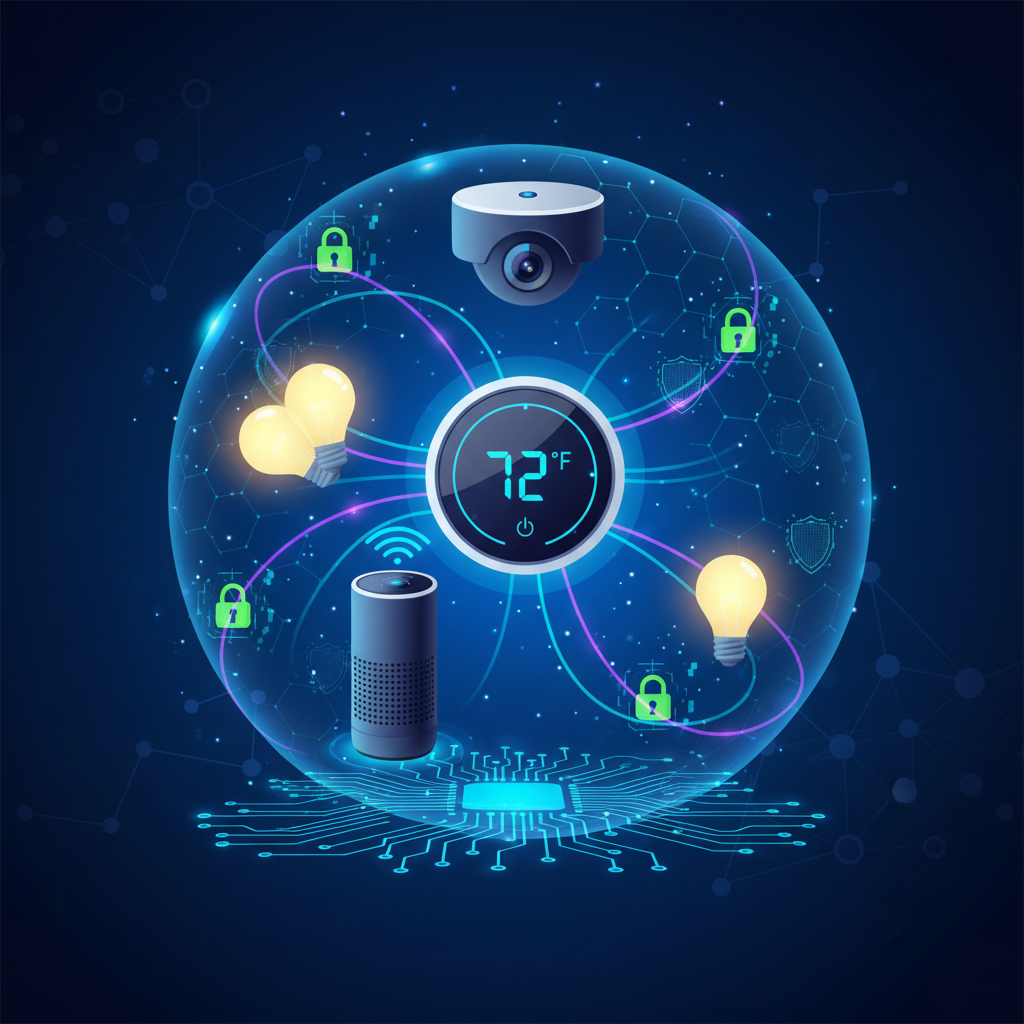
Safeguarding Your Sanctuary: Smart Home Security & Privacy in the AI Era
Safeguarding Your Sanctuary: Smart Home Security & Privacy in the AI Era

Introduction: The Double-Edged Sword of the Connected Home
The allure of a smart home is undeniable. Imagine your lights dimming automatically as you settle in for movie night, your thermostat adjusting to your comfort before you even arrive, and your doors locking themselves the moment you leave. This seamless integration, driven by home automation security and the Internet of Things (IoT), promises unparalleled convenience and efficiency. However, this connected utopia comes with its own set of challenges, particularly concerning smart home security and smart home privacy. In an era increasingly defined by Artificial Intelligence, understanding and mitigating the connected home risks is not just advisable; it’s essential for digital security for homes.
This comprehensive guide will delve deep into the world of IoT security, exploring how to protect your digital sanctuary from evolving threats. We’ll uncover the potential smart home vulnerabilities, discuss the critical aspects of data privacy smart devices, and equip you with the knowledge and strategies for preventing smart home breaches. From implementing best smart home security systems to understanding ethical AI in smart homes, prepare to transform your connected residence into a fortress of both innovation and impregnable safety.
The Smart Home Revolution: Convenience Meets Complexity
The rapid adoption of smart devices has transformed our living spaces. From voice assistants like Alexa and Google Home to smart thermostats, lighting systems, and security cameras, our homes are becoming increasingly intelligent. This revolution is powered by IoT, a vast network of physical objects embedded with sensors, software, and other technologies that connect and exchange data over the internet.
The Appeal of Automation and Remote Control
The primary drivers for smart home adoption are convenience and control. Imagine:
- Energy Efficiency: Smart thermostats learning your habits to optimize heating and cooling, leading to lower utility bills. For more on sustainable tech, check out our guide on Sustainable Smart Home Energy-Saving Gadgets.
- Enhanced Comfort: Automated lighting, blinds, and entertainment systems tailored to your preferences.
- Peace of Mind: Remote monitoring of your home, receiving alerts about unusual activity, and controlling access from anywhere.
The Shadow Side: Unseen Risks and Vulnerabilities
While the benefits are clear, the interconnected nature of smart homes also introduces significant risks. Every connected device is a potential entry point for malicious actors. Without proper IoT security measures, your smart home can become a target, leading to privacy intrusions, data theft, and even physical security breaches. This is why protecting smart home devices is paramount for smart home hacks prevention.

Image: A visual representation contrasting the physical, tangible elements of a traditional home security system (e.g., deadbolt, alarm box) with the interconnected, digital nature of a modern smart home security system (e.g., smart camera, smart lock, central hub).
Understanding the Landscape of Smart Home Vulnerabilities
The complexity of a smart home ecosystem means there are numerous points of potential failure or exploitation. Recognizing these smart home vulnerabilities is the first step in building a robust defense.
H3. Common Attack Vectors and Entry Points
Cybercriminals often exploit common weaknesses to gain unauthorized access:
- Weak Passwords: Default or easily guessable passwords (e.g., “admin,” “123456”) are an open invitation to hackers. Every new smart device must have its default credentials changed immediately upon installation.
- Unpatched Software: Outdated firmware on devices frequently contains known security flaws that manufacturers have addressed in updates. Neglecting smart home device updates leaves these doors wide open.
- Insecure Network Configurations: A poorly secured Wi-Fi network acts as a gateway to all connected devices. Without proper encryption and access control, your entire home network is exposed.
- Phishing and Social Engineering: These tactics involve tricking users into revealing sensitive information, such as login credentials, or installing malicious software disguised as legitimate updates or applications.
The Inherent Challenges of IoT Security
IoT security is inherently challenging due to several factors:
- Device Diversity: The sheer variety of manufacturers, operating systems, and security standards makes it difficult to apply a one-size-fits-all security solution.
- Resource Constraints: Many IoT devices are designed to be small, inexpensive, and energy-efficient, often having limited processing power, memory, and battery life. This can make it difficult to implement strong encryption or complex security protocols effectively.
- Lack of Updates and Support: Some manufacturers abandon devices quickly, failing to provide long-term software support and leaving them vulnerable to new threats and exploits. This highlights the importance of choosing reputable brands when considering best smart home security systems.
Device-Specific Risks: Where Your Home is Most Exposed
Specific smart home devices, due to their function, often present unique security and privacy challenges, demanding focused attention for protecting smart home devices.
H4. Smart Door Locks Security
The convenience of keyless entry or remote unlocking comes with inherent risks. If not properly secured, smart door locks security systems can be vulnerable to remote exploitation, brute-force attacks, or even physical tampering if the underlying smart technology is weak. Robust encryption, strong authentication methods, and regular software updates are critical to prevent unauthorized access.
H4. Smart Cameras Privacy and Security Concerns
Security cameras are designed to monitor your home, but without stringent smart cameras privacy settings, they can become tools for surveillance against you. Unsecured cameras can be hacked, allowing unauthorized individuals to view your home, listen to conversations, or even use them as entry points into your network. Implementing two-factor authentication smart home and strong, unique passwords are critical, as is understanding where your camera’s data is stored and who has access.
H4. Securing Alexa and Google Home: Voice Assistant Privacy
Voice assistants are always listening, waiting for their wake word. This continuous listening raises significant voice assistant privacy concerns. While data is typically processed locally before being sent to the cloud, the potential for eavesdropping or unauthorized recording exists if security is breached or privacy settings are lax. It’s crucial to review and manage privacy settings, delete voice recordings regularly, and understand what data these devices collect and store. For more on AI tools and productivity, see our article on Unlocking the Potential: Top AI Tools for Everyday Productivity.
The AI Advantage: Boosting Home Security
While AI introduces new considerations for privacy, it also represents a powerful ally in the fight for smart home security. AI home security systems leverage machine learning algorithms to detect anomalies, predict threats, and automate responses, significantly enhancing protection.
How AI Enhances Security and Threat Detection
AI-powered home protection is transforming security in several ways, moving beyond simple rule-based systems:
- Behavioral Analytics: AI can learn the normal patterns of your home – when lights are usually on, typical door activity, family routines. Any deviation from these patterns can trigger an alert, offering early detection of potential intrusions or unusual events. This is a game-changer for preventing smart home breaches.
- Advanced Motion and Sound Detection: Beyond simple motion, AI can distinguish between pets, vehicles, and humans, reducing false alarms from smart cameras privacy systems. Some systems can even identify familiar faces, specific vehicles, or recognize unusual sounds like glass breaking.
- Threat Prediction and Anomaly Detection: By analyzing vast amounts of historical and real-time data, AI can identify emerging threats and vulnerabilities, allowing for proactive security measures rather than reactive ones. This contributes significantly to the future of home security.
- Automated Responses: In an emergency, AI can initiate predefined actions, such as locking doors, turning on all lights, contacting emergency services, or activating alarms, even if you’re not home, ensuring swift smart home device control.

Image: A stylized, glowing AI brain icon at the center, radiating lines connecting it to various smart home security elements like CCTV cameras, smart locks, biometric sensors, and network symbols, symbolizing AI as the intelligent core of home protection.
Ethical AI in Smart Homes: A Necessary Balance
The power of AI also brings ethical responsibilities that must be carefully managed. Ethical AI in smart homes requires developers and users to consider:
- Bias and Fairness: Ensuring AI algorithms are designed and trained in a way that is free from biases that could lead to discriminatory outcomes or misidentifications.
- Transparency and Explainability: Users should have a clear understanding of how AI systems make decisions, what data they process, and why certain actions are taken. This builds trust in AI home security.
- Accountability: Establishing clear lines of responsibility when an AI system makes a mistake, misidentifies a threat, or is compromised.
- Privacy-by-Design: Integrating privacy considerations from the very beginning of AI system development, ensuring data minimization, robust encryption, and granular user controls to safeguard smart home privacy.
The future of home security undoubtedly involves more sophisticated AI, but its success hinges on building trust through transparent and ethical implementation.
Fortifying Your Digital Sanctuary: Best Practices for Smart Home Security
Building a truly secure smart home requires a multi-layered approach. It’s about combining robust technology with diligent user practices. Here’s how to ensure comprehensive cybersecurity for smart homes.
Secure Smart Home Installation: Laying the Foundation for Safety
The initial setup of your smart devices is critical and often overlooked.
- Change All Default Credentials: This is the absolute first step for any new device. Default usernames and passwords are often publicly known or easily guessed, making them a primary target for hackers.
- Research Before You Buy: Choose reputable brands with a strong track record of security, regular firmware updates, and transparent privacy policies. Look for devices that clearly outline their data privacy smart devices policies and commit to long-term support.
- Dedicated Guest Networks: If available on your router, consider setting up a separate Wi-Fi network specifically for your smart devices, especially those with lower security requirements or less sensitive functions. This isolates them from your main network where personal computers and critical data reside.
Network Security Smart Home: The Digital Walls of Your Fortress
Your home network is the backbone of your smart home, connecting all your devices. Securing it is paramount for preventing smart home breaches.
- Strong, Unique Router Password: Just like device passwords, your router’s administrative password must be strong, complex, and unique. Change it from the default immediately.
- Enable WPA3/WPA2-AES Encryption: Ensure your Wi-Fi network uses the strongest possible encryption protocols. WPA3 is the most secure; if not available, use WPA2-AES. Avoid WEP and WPA/WPA2-TKIP entirely.
- Firewall Protection: Most modern routers have built-in firewalls. Ensure it’s enabled and properly configured to filter suspicious inbound and outbound traffic, protecting your devices from external threats.
- VPN for Smart Home Devices: For an extra layer of security and privacy, especially for devices handling sensitive data or those that might connect to external servers, consider setting up a VPN for smart home devices at the router level. This encrypts all traffic leaving your home network, making it much harder for eavesdroppers to intercept data or track your online activity.
- Network Segmentation (Advanced): For those with technical expertise, creating separate subnetworks (VLANs) for critical smart devices (like security cameras and smart door locks) and general IoT devices can significantly enhance IoT security by isolating potential compromises.

Image: A conceptual illustration depicting a central, secure Wi-Fi router emitting a protected network signal that seamlessly connects to various smart home devices – including a smart lock, security camera, thermostat, and a voice assistant speaker – all enclosed within a protective digital shield, emphasizing a secure network environment.
Protecting Smart Home Devices: Individual Guardianship
Beyond network security, each device needs individual attention to ensure safe smart home practices.
- Strong, Unique Passphrases: Every single smart device and its associated app should have a strong, unique password or passphrase. Never reuse passwords. Password managers are invaluable tools for this.
- Two-Factor Authentication Smart Home: Whenever possible, enable two-factor authentication smart home (2FA) for your smart home accounts and devices. This adds a critical layer of security by requiring a second form of verification (e.g., a code from your phone, a fingerprint scan) in addition to your password, making it significantly harder for unauthorized users to gain access.
- Smart Home Device Updates: Regularly check for and install smart home device updates and firmware patches. Manufacturers frequently release updates to fix newly discovered vulnerabilities and improve device security. Enable automatic updates if the feature is available and reliable.
- Review App Permissions: When installing companion apps for smart devices, carefully review the permissions they request. Does a smart bulb app truly need access to your contacts or location? Restrict unnecessary access to enhance smart home privacy.
Smart Home Device Management and Control
Active and ongoing management is key to maintaining continuous security in your connected home.
- Smart Home Device Control: Regularly audit your connected devices. Do you still use everything that’s plugged into your network? Remove or disable devices you no longer need, as they can become forgotten security liabilities.
- Regular Security Audits: Periodically review your device settings, privacy policies, and network logs for any unusual activity. Many smart home hubs or router apps offer dashboards to help with this.
- Physical Security: Don’t forget that physical access can compromise smart devices. Ensure your home network hardware (router, smart home hubs) is in a secure location, preferably locked away or in an area with limited access.
Navigating Smart Home Privacy Concerns
While security focuses on preventing unauthorized access, privacy revolves around how your personal data is collected, used, and shared. Smart home privacy is a growing concern, especially with the proliferation of sensors, microphones, and cameras in our living spaces and the increasing use of AI.
Data Privacy Smart Devices: What’s Being Collected?
Almost every smart device collects some form of data. This can include:
- Usage Data: How often you use a device, what features you access, and at what times.
- Environmental Data: Temperature, humidity, light levels, air quality readings from smart thermostats or environmental sensors.
- Audio/Visual Data: Recordings and live feeds from smart cameras privacy and voice assistant privacy devices.
- Personal Identifiable Information (PII): Names, addresses, payment information, linked accounts, and even biometric data in some cases.
This data is often used to improve services, personalize experiences, and, in some cases, for targeted advertising. Understanding a device’s IoT privacy concerns and its smart home data protection policy is vital before integrating it into your home.
Managing Your Digital Footprint: Practical Privacy Tips
Proactive steps can significantly enhance your smart home data protection and help you maintain control over your personal information.
- Read Privacy Policies Thoroughly: Before buying and setting up a device, read its privacy policy. Understand what data is collected, why, how long it’s stored, and how it’s shared with third parties. If a policy is unclear or concerning, reconsider the purchase.
- Adjust Privacy Settings: Most smart devices and their companion apps offer granular privacy settings. Take the time to customize these to your comfort level. Limit data sharing, disable unnecessary features like location tracking, and restrict microphone or camera access when they are not actively in use.
- Delete Voice Recordings Regularly: Voice assistants often store recordings of your commands to improve their service. Regularly review and delete these recordings through the app settings to minimize your digital footprint.
- Consider Data Minimization: Only provide the data that is absolutely necessary for the device to function as intended. If a device can work perfectly well without certain permissions, deny them.
- Guest Mode for Voice Assistants: If you have guests, enable a guest mode on your voice assistant, if available, to prevent their interactions from being associated with your personal profile or stored as your data.

Image: A close-up view of a smartphone screen displaying a user interface for “Privacy Settings” within a generic smart home application. On the screen, there are toggle switches and selectable options for features such as “Data Sharing,” “Location Services,” “Microphone Access,” and a button labeled “Delete Voice Recordings,” allowing users to configure their privacy preferences.
Choosing the Right Arsenal: Best Smart Home Security Systems
Investing in a robust smart home security system is a cornerstone of protecting your sanctuary. When evaluating options, consider more than just the price tag; security and privacy features should be paramount.
Key Features to Look For in a System
- Integration Capabilities: Does the system integrate seamlessly with your existing devices (like smart door locks security, smart cameras privacy, and voice assistants) and other smart home platforms you use? A cohesive ecosystem is often more secure and easier to manage.
- Professional Monitoring: For enhanced home automation security, consider systems that offer 24/7 professional monitoring. In case of an alarm, a trained team can dispatch emergency services, providing an invaluable layer of protection.
- Redundant Communication: Systems that use both Wi-Fi and cellular backup ensure continued operation during internet outages or power cuts, preventing gaps in your security.
- Strong Encryption Standards: Look for systems that use strong end-to-end encryption for all data transmission, both locally and to cloud servers. This is vital for data privacy smart devices.
- Ease of Use and Management: A system that’s easy to install, manage through an intuitive app, and monitor is more likely to be used effectively. Complexity can lead to security oversights.
- Manufacturer Reputation and Support: Choose brands known for their commitment to security, regular smart home device updates, and responsive customer support. Longevity of support is crucial for IoT security.
- Privacy-Focused Design: Prioritize systems that offer granular control over smart cameras privacy and data privacy smart devices, and clearly outline their data handling practices in accessible privacy policies.
The Future of Home Security: Ethical AI and Ever-Evolving Defenses
As technology advances at an unprecedented pace, so too do the threats. The future of home security will be characterized by increasingly sophisticated AI home security systems and a constant arms race against new smart home vulnerabilities.
Anticipating New Threats and Challenges
- Deepfakes and Voice Mimicry: AI could be maliciously used to generate highly realistic fake voices or images to bypass voice or facial recognition security systems, posing a serious threat to smart door locks security and user authentication.
- Supply Chain Attacks: Vulnerabilities introduced at the manufacturing stage of smart devices could compromise devices before they even reach your home, making it harder for consumers to detect.
- Quantum Computing: While still a distant threat, the advent of powerful quantum computers could theoretically break current encryption standards, necessitating entirely new cryptographic approaches for cybersecurity for smart homes.
- AI vs. AI: The emergence of adversarial AI could see malicious AI systems attempting to exploit or disable defensive AI systems within smart homes.
Innovations in Protection and Resilience
- Self-Healing Networks: The development of network security smart home systems that can automatically detect, isolate, and remediate compromised devices or segments of the network without human intervention.
- Zero-Trust Architectures: Moving away from the traditional “trust-inside” model, future systems will likely implement zero-trust, verifying every device, user, and application, regardless of whether they are inside or outside the network, continuously validating access.
- Behavioral Biometrics: Beyond traditional fingerprints or facial recognition, systems might analyze unique user behaviors (e.g., typing patterns, gait, voice cadence) for continuous authentication, making it harder for intruders.
- Ethical AI in Smart Homes Frameworks: As AI becomes more deeply integrated, robust frameworks for ethical AI in smart homes will be crucial to ensure these powerful tools are used responsibly, transparently, and without infringing on individual privacy, balancing innovation with human rights.
The constant evolution in the digital landscape means that vigilant attention to smart home device updates and staying informed about safe smart home practices will remain critical responsibilities for every homeowner in the AI era. You can always stay up-to-date with the latest tech and trends by visiting HyperDaily’s blog.
Conclusion: Securing Your Smart Home, Protecting Your Peace of Mind
The journey through the world of smart home security and smart home privacy in the AI era reveals a landscape brimming with innovation but also inherent challenges. From the convenience of home automation security to the necessity of robust IoT security, every connected device brings both potential and responsibility.
By understanding connected home risks, implementing comprehensive cybersecurity for smart homes, and actively managing your data privacy smart devices, you can transform your intelligent residence into a truly safe and private sanctuary. Remember the foundational importance of strong, unique passwords, activating two-factor authentication smart home, performing regular smart home device updates, and diligently exercising smart home device control. Embrace AI home security for its protective power, but always insist on ethical AI in smart homes that respects your privacy.
The future of home security depends on vigilance, education, and proactive measures. Don’t let the convenience of smart living compromise your safety or privacy. Empower yourself with knowledge, secure your devices, and enjoy the profound peace of mind that comes from a truly protected smart home.
Ready to take control of your digital home and explore more topics on modern living and technological advancements? Visit https://hyperdaily.one/blog/ for more insights.
FAQs
Q1. What are the biggest smart home security threats?
The biggest smart home security threats include weak default passwords, unpatched software vulnerabilities in devices, insecure Wi-Fi networks, and phishing attempts. These can lead to unauthorized access, data breaches, and even physical security compromises through devices like smart door locks security systems or smart cameras privacy systems.
Q2. How can I improve my smart home’s network security?
To enhance network security smart home, use a strong, unique password for your router, enable WPA3 or WPA2-AES encryption, keep your router’s firmware updated, and activate its built-in firewall. For an extra layer of protection, consider implementing a VPN for smart home devices to encrypt all your network traffic.
Q3. Is my smart camera watching me all the time?
While smart cameras privacy features vary, most are designed to record only when motion is detected, when specific events occur, or when you actively view the live feed. However, some can be configured for continuous recording. It’s crucial to check your device’s privacy settings, disable unnecessary recording, and use strong passwords and two-factor authentication smart home to prevent unauthorized access.
Q4. How does AI improve home security?
AI home security leverages machine learning to enhance detection, prediction, and response. AI can analyze patterns to detect anomalies, differentiate between actual threats and false alarms (e.g., distinguishing pets from intruders), and automate security responses, making your best smart home security systems more intelligent and proactive.
Q5. What are the key steps for protecting my smart home data privacy?
To protect your smart home data protection, always read privacy policies before using devices, adjust privacy settings in companion apps to limit data collection, disable features you don’t use, and regularly delete sensitive data like voice recordings. Being aware of data privacy smart devices and IoT privacy concerns is key to maintaining control.
Q6. Should I use two-factor authentication for my smart home devices?
Yes, absolutely. Enabling two-factor authentication smart home (2FA) for all smart home accounts and devices that support it is one of the most effective ways to prevent unauthorized access. It adds an essential layer of security beyond just a password, significantly reducing the risk of smart home hacks prevention.
Q7. How often should I update my smart home devices?
You should check for and install smart home device updates as soon as they become available. Manufacturers frequently release updates to patch security vulnerabilities and improve performance and features. Enabling automatic updates, if offered and reliable, is the most convenient way to ensure your devices always have the latest security protections.
Q8. Are voice assistants like Alexa and Google Home secure?
While companies implement significant security measures, securing Alexa and Google Home requires user vigilance. Concerns revolve around voice assistant privacy and the potential for eavesdropping or unauthorized data collection. To enhance security, review and delete voice recordings, manage privacy settings in the app, and understand what data these devices collect and how it’s used.